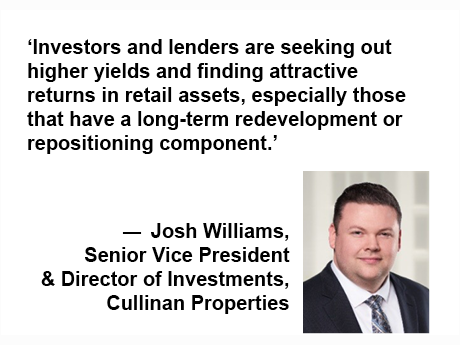Josh Williams, senior vice president and director of investments out of Cullinan Properties’ Houston office, has been closely monitoring the leasing, development and sales activity for brick and mortar since our national emergence from the pandemic began. Below are the trends he sees, and where he believes this market is headed.
Retail Insight: What would you say is the overarching trend in retail real estate right now?
Williams: As we emerge from the pandemic, we are seeing a wide variety of retail assets returning to pre-2020 activity levels, all with one overarching trait: quality. The quality retail assets — whether they’re grocery, lifestyle, mixed-use or even dominant power centers — are performing well from both an operational and investment perspective.
Tenant demand is also strong with 2021 openings outpacing closings 2:1. This is driving rental rate growth, occupancy and investor interest. Beyond the Class A and B quality assets, though, retail inventory continues to need significant downsizing.
Retail Insight: How would you define the retail investment market right now? What are investors chasing?
Williams: Investment activity is closely following performance, with renewed interest in many types of retail centers. Multifamily, industrial and storage investments have saturated the market in recent years, but we have seen a surge of interest in retail properties. Investors and lenders are seeking out higher yields and finding attractive returns in retail assets, especially those that have a long-term redevelopment or repositioning component. Those are one of the primary types of assets we are targeting here at Cullinan Properties. We will use our retail expertise and experienced development platform to reimagine the asset, driving compelling returns for our investors.
Retail Insight: What about lifestyle and mixed-use centers? How are they performing?
Williams: While many of these properties struggled the hardest during the pandemic, lifestyle and mixed-use assets have emerged strong on both the consumer and tenant fronts. Activities are returning to normal, and the customer demand for experiential, mixed-use retail continues to grow. Lifestyle tenants have increased store openings, including digitally native brands that are using brick-and-mortar stores to connect with their customers.
Retail Insight: What strategies have been successful in terms of attracting buyers and tenants to mixed-use properties, specifically?
Williams: Mixed-use real estate has a built-in customer base of office tenants, residents, hotel guests, etc., that drive traffic, but the on-site customer experience is the most critical. Place-making efforts, robust programming and the pedestrian experience are key elements to any successful mixed-use development. This helps drive consumers to the site, increases dwell times and ultimately increases tenant sales. Place-making and lifestyle tenant fit-outs are costly, though, so investors are seeing a large portion of their return from the premium on office and multifamily rents when they are adjacent to these mixed-use retail amenities.
— Compiled by Nellie Day. This post is posted as part of Shopping Center Business’ Retail Insight series. Click here to subscribe to the Retail Insight newsletter, a four-part newsletter series, followed by video interviews delivered to your inbox in May/June.


